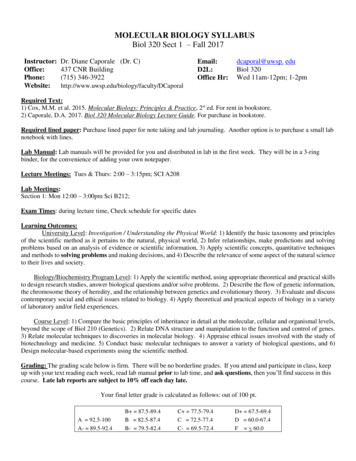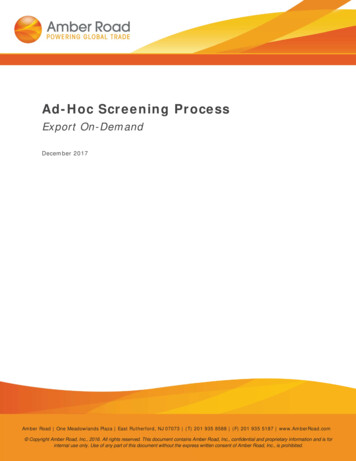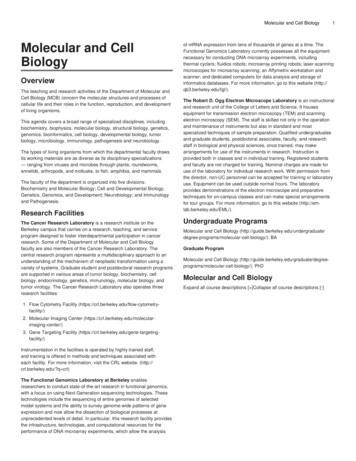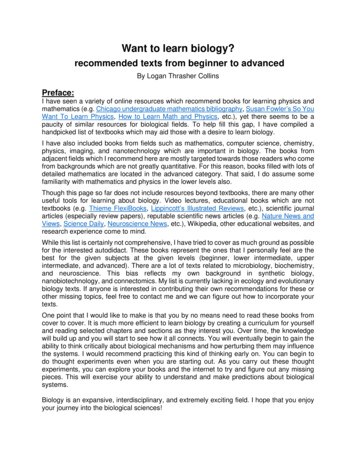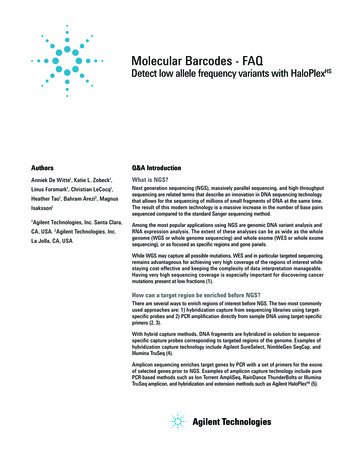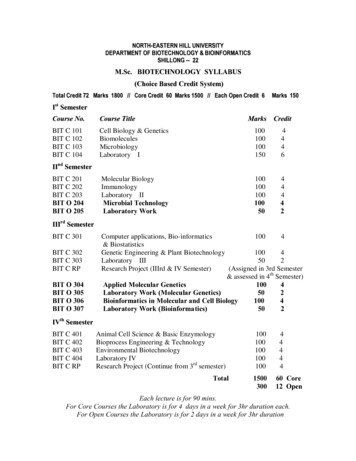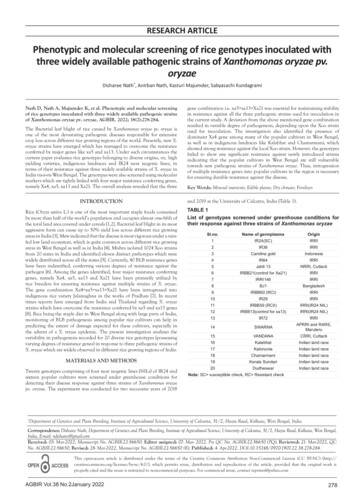
Transcription
RESEARCH ARTICLEPhenotypic and molecular screening of rice genotypes inoculated withthree widely available pathogenic strains of Xanthomonas oryzae pv.oryzaeDisharee Nath*, Anirban Nath, Kasturi Majumder, Sabyasachi KundagramiNath D, Nath A, Majumder K, et al. Phenotypic and molecular screeningof rice genotypes inoculated with three widely available pathogenic strainsof Xanthomonas oryzae pv. oryzae. AGBIR. 2022; 38(2):278-284.The Bacterial leaf blight of rice caused by Xanthomonas oryzae pv. oryzae isone of the most devastating pathogenic diseases responsible for extensivecrop loss across different rice growing regions of the world. Presently, new X.oryzae strains have emerged which has managed to overcome the resistanceconferred by major genes like xa5 and xa13. Under such circumstances thecurrent paper evaluates rice genotypes belonging to diverse origins, viz. highyielding varieties, indigenous landraces and IR24 near isogenic lines, interms of their resistance against three widely available strains of X. oryzae inIndia vis-à-vis West Bengal. The genotypes were also screened using molecularmarkers which are tightly linked with four major resistance conferring genes,namely Xa4, xa5, xa13 and Xa21. The overall analysis revealed that the threeINTRODUCTIONRice (Oryza sativa L.) is one of the most important staple foods consumedby more than half of the world’s population and occupies almost one-fifth ofthe total land area covered under cereals [1,2]. Bacterial leaf blight in its mostaggressive form can cause up to 50% yield loss across different rice growingareas in India [3]. Mew indicated that the disease is most vigorous under a rainfed low land ecosystem, which is quite common across different rice growingareas in West Bengal as well as in India [4]. Mishra isolated 1024 Xoo strainsfrom 20 states in India and identified eleven distinct pathotypes which werewidely distributed across all the states [5]. Currently, 40 BLB resistance geneshave been indentified, conferring various degrees of resistance against thepathogen [6]. Among the genes identified, four major resistance conferringgenes, namely Xa4, xa5, xa13 and Xa21 have been primarily utilized byrice breeders for ensuring resistance against multiple strains of X. oryzae.The gene combination Xa4 xa5 xa13 Xa21 have been introgressed intoindigenous rice variety Jalamaghna in the works of Pradhan [7]. In recenttimes reports have emerged from India and Thailand regarding X. oryzaestrains which have overcome the resistance conferred by xa5 and xa13 genes[8]. Rice being the staple diet in West Bengal along with large parts of India,monitoring of BLB pathogenesis among popular rice cultivars can help inpredicting the extent of damage expected for these cultivars, especially inthe advent of a X. oryzae epidemic. The present investigation analyses thevariability in pathogenesis recorded for 20 diverse rice genotypes (possessingvarying degrees of resistance genes) in response to three pathogenic strains ofX. oryzae which are widely observed in different rice growing regions of India.MATERIALS AND METHODSTwenty genotypes comprising of four near isogenic lines (NILs) of IR24 andsixteen popular cultivars were screened under greenhouse conditions fordetecting their disease response against three strains of Xanthomonas oryzaepv. oryzae. The experiment was conducted for two successive years of 2018gene combination i.e. xa5 xa13 Xa21 was essential for maintaining stabilityin resistance against all the three pathogenic strains used for inoculation inthe current study. A deviation from the above mentioned gene combinationresulted in variable degree of pathogenesis, depending upon the Xoo strainused for inoculation. The investigation also identified the presence ofdominant Xa4 gene among many of the popular cultivars in West Bengal,as well as in indigenous landraces like Kalabhat and Chamarmani; whichshowed strong resistance against the local Xoo strain. However, the genotypesfailed to show any significant resistance against newly introduced strainsindicating that the popular cultivars in West Bengal are still vulnerabletowards new pathogenic strains of Xanthomonas oryzae. Thus, introgressionof multiple resistance genes into popular cultivars in the region is necessaryfor ensuring durable resistance against the disease.Key Words: Mineral nutrients; Edible plants; Dry climate; Fertilizerand 2019 at the University of Calcutta, India (Table 1).TABLE 1List of genotypes screened under greenhouse conditions fortheir response against three strains of Xanthomonas oryzaeSl.no.Name of germplasmsOrigin1IR24(SC)IRRI2IR36IRRI3Carolina goldIndonesia4IR64IRRI5Jaldi 13NRRI, Cuttack6IRBB21(control for Xa21)IRRI7IRRI146IRRI8BJ1BangladeshIRRI9IRBB60 (RCI)10IR29IRRI11IRBB59 (RCII)IRRI(IR24 NIL)12IRBB13(control for xa13)IRRI(IR24 NIL)13IR72IRRI14SWARNAAPRRI and RARS,Maruteru15VANDANACRRI, Cuttack16KalabhatIndian land race17KalonuniaIndian land race18ChamarmaniIndian land race19Kerala SundariIndian land race20DudheswarIndian land raceNote: SC susceptible check, RC Resistant checkDepartment of Genetics and Plant Breeding, Institute of Agricultural Science, University of Calcutta, 51/2, Hazra Road, Kolkata, West Bengal, India1Correspondence: Disharee Nath, Department of Genetics and Plant Breeding, Institute of Agricultural Science, University of Calcutta, 51/2, Hazra Road, Kolkata, West Bengal,India, E-mail: ndisharee@gmail.comReceived: 03- Mar-2022, Manuscript No. AGBIR-22-56650; Editor assigned: 07- Mar- 2022, Pre QC No. AGBIR-22-56650 (PQ); Reviewed: 21- Mar-2022, QCNo. AGBIR-22-56650; Revised: 28- Mar-2022, Manuscript No. AGBIR-22-56650 (R); Published: 4- Apr-2022, DOI:10.35248/0970-1907.22.38.278-284.This open-access article is distributed under the terms of the Creative Commons Attribution Non-Commercial License (CC BY-NC) (http://creativecommons.org/licenses/by-nc/4.0/), which permits reuse, distribution and reproduction of the article, provided that the original work isproperly cited and the reuse is restricted to noncommercial purposes. For commercial reuse, contact reprints@pulsus.comAGBIR Vol.38 No.2January 2022278
Nath, et al.The IR24 near isogenic lines IRBB60 and IRBB59 were designated asresistant checks, carrying the Xa4 xa5 xa13 Xa21 and xa5 xa13 Xa21resistance gene combinations respectively. The NILs IRBB13 and IRBB21were designated as controls for the gene xa13 and Xa21 respectively. Thegenotype IR24 was designated as the susceptible check.were classified as per IRRI (Table 2).TABLE 2Scoring of genotypes for disease responseLesion length (cm)Green house screeningThe twenty genotypes evaluated in the current experiment were germinatedin sterilized petri-plates containing moist filter papers using ultrapure Mili-Qwater. Following germination and seedling emergence, the seedlings wereplaced in pots of 20 cm diameter. The pot soil was sterilized by autoclavingat 121oC for 20 minutes. Twenty one days old seedlings were transferred tolarger pots of 40 cm diameter. 1.0 g of N.P.K at 15:15:15 dose was addedalong with 0.2 g of 46% Urea at 15 days from transplanting into large pots,as suggested in the works of Banito [9]. Plants were watered at alternate days.The greenhouse temperature was set at a range of 28 to 30oC. The relativehumidity was maintained at 90 to 95%.Disease reaction0-5Resistance (R) 5-10Moderately Resistant (MR) 10-15Moderately Susceptible (MS) 15Susceptible (S)Screening of genotypes using molecular markers tightly linked withfour BLB resistance genes Xa4, xa5, xa13 and Xa21The marker assisted screening was performed using molecular markers whichare tightly linked with four major resistance conferring genes, viz. Xa4, xa5,xa13 and Xa21 (Table 3). Plant DNA was extracted from leaf samples of 20genotypes using DNeasy Plant Mini Kit (Maker: Qiagen). The polymerasechain reaction was conducted in a reaction solution of 25 µl containingtemplate DNA, primers, dNTPs, reaction buffer, MgCl2 and Taq Polymerase.The PCR amplification was performed using an Eppendorf thermo-cycler.The PCR cycle profile involved 4 minutes of denaturation at 94 C followedby 35 cycles of 30 seconds denaturation at 94 C. Then a 60 secondsannealing was allowed at 55 C followed by 60 seconds extension at 72 C.Final extension was allowed at 72 C for 5 minutes. The PCR products wereresolved using 1.5% Agarose gel for the marker pTA248. 2% Agarose gel wasused for the rest of the markers. A 50 to 1000 bp long DNA ladder was usedfor analyzing the size of amplified products. Bands were visualized under UVlight using the gel documentation system. Resistance and susceptible alleleswere observed and recorded for further study.Maintaining of Xoo strainsThe purified isolates of X. oryzae were maintained in 500 µl of 20% glycerolat - 20 C. Three strains of X. oryzae which are widely available in India wereused for the experiment. Two strains, viz. IX021 and IX027 were collectedfrom IIRR (Indian Institute of Rice Research). The third strain was a localisolate collected from Rice Research Station, Chinsurah, and West Bengal,India. The local isolate was designated as CUXo1.Inoculation of genotypes with the three pathogenic strainsThe bacterial suspension was adjusted to a concentration of 108 cfu ml-1and the host plants were inoculated using the clipping method suggestedby Kauffman [10]. The method involved clipping the leaf tip using scissorsdipped in bacterial suspension at a height of 3 cm from the tip of a healthyleaf. The inoculation was carried out during active tillering stage of the hostplants.Statistical analysisThe pooled data was analyzed using Duncan's multiple range test (DMRT)using SPSS version 20.0 [11]. The pooled LSD at 5% significance level wascalculated from pooled analysis of variance. Cluster analysis was performedon the basis of the allelic data recorded for the genotypes tested; using genespecific molecular markers. UPGMA (Unweighted Pair Group Method withArithmetic Mean) method of clustering was followed and a dendrogram wasconstructed using Darwin version 6.0 [12].Collection of data associated with lesion lengthInfected leaves from three replicates of each genotype inoculated separatelyby the three strains were collected and lesion length was measured at fourteendays after inoculation. Based on the lesion length recorded, the genotypesTABLE 3Markers used for identifying three resistant genes towards acgaggRM224Rtgctataaaaggcattcgggxa5s-F (Multiplex)gtctggaatttgctcgcgttcgxa5s-R ex)tgacttggttctccaaggcttXa13 Prom-FggccatggctcagtgtttatXa13 Prom-RgagctccagctctccaaatgpTA248 FagacgcggaagggtggttcccggapTA248 RagaccggtaatcgaaagatgaaaSun et al. (2003)Xa45Pradhan et al. (2015)xa58Sundaram et al. (2011)xa1311Pradhan et al. (2015)Xa21279ReferenceAGBIR Vol.38 No.2 January 2022
Phenotypic and molecular screening of rice genotypes inoculated with three widely available pathogenic strains of Xanthomonas oryzaepv. oryzaeRESULTSTwenty diverse genotypes were screened for analyzing their response towardsthree invasive strains of bacteria Xanthomonas oryzae. The average leaf lesionlengths were calculated over two years for the genotypes, which were inoculatedwith three pathogenic BLB strains (Table 4). For the Xoo strain IX021, aformidable resistance was observed among the check varieties IRBB60 andIRBB59; which could not be matched by any other genotype except IRBB21. Thesimilar response of the three genotypes was further confirmed by the Duncan'smultiple range tests.On the other hand, a moderate degree of resistance was observable for thecultivars, namely Carolina Gold, IR64, IRBB13 and Swarna. Among thepopular landraces indigenous to West Bengal, only Kalabhat and Chamarmaniexhibited a moderate resistance against the strain IX021, whereas landraces likeKalonunia, Kerala Sundari and Dudheswar exhibited moderate to completesusceptibility against the strain. The results from the DMRT further confirm thesimilar pathogenicity observed among genotypes inoculated with IX021.The disease development observed among the genotypes in response to thestrain IX027 was also recorded. The investigation identified a single variety Bj1which exhibited significant resistance against IX027, which was at par with thechecks IRBB60 and IRBB59. The similar responses of the three genotypes werereconfirmed using DMRT.Conversely, a moderate resistance was observable for IRBB21 in response tothe pathogenic strain IX027. Rest of the genotypes exhibited susceptible ormoderately susceptible reactions against the strain. The local landraces Kalabhatand Chamarmani failed to show significant resistance against the strain, insteadexhibited moderate susceptibility. Other indigenous varieties like Kalonunia,Kerala Sundari and Dudheswar showed complete susceptibility against the strain.Lastly, the genotypes were screened for analyzing their pathogenesis against thelocal isolate CUXo1. Other than the landraces Kalabhat and Chamarmani, noother genotype exhibited significant resistance at par with the (resistant) checksIRBB59 and IRBB60.The genotypes Carolina Gold and IRBB21 on the other hand exhibited amoderate resistance against the strain. Other landraces analyzed in the currentstudy, namely Kalonunia, Kerala Sundari and Dudheswar exhibited severedamage from BLB infection; indicating their susceptibility towards the strain.From the phenotypic observations it was evident that variability in terms ofpathogenesis can be expected among the cultivars in response to the pathogenicstrains, only exception being IRBB59 and IRBB60 which showed a stableresistance against the three strains. Variability in terms of pathogenesis of BLBhas been earlier reported by Ogawa [13].The phenotypic observations were corroborated at genotypic level usingmolecular markers which are tightly linked with four major resistance conferringgenes, namely Xa4, xa5, xa13 and Xa21. The marker assisted screening ofthe genotypes elucidated the presence or absence of desirable alleles for thecorresponding BLB resistance genes. The presence of the dominant allele forthe gene Xa4 was detected using the marker RM224. The marker amplifieda 160 bp resistance allele for the check variety IRBB60. On the other handthe susceptible check IR24 exhibited an allele size of 140 bp, when evaluatedusing the primer RM224. The 160 bp resistance allele similar to the checkvariety IRBB60 was also detected in the genotypes IR36, IR64, IR29 andJALDI 13 (Figure 1). Among the indigenous landraces the resistance allele forXa4 was detected in genotypes, namely Kalabhat, Chamarmani and Dudheswar.The marker RM224 was successfully used for the detection of Xa4 gene amongvarious rice genotypes in the works of Singh [14].For the detection of xa5, genotypes were screened using the primer xa5 s(multiplex). The primer amplified a 160 bp resistance allele in the check varietiesIRBB59 and IRBB60 (Figure 2). On the other hand the susceptible checkIR24 exhibited the presence of a 310 bp susceptible allele. In addition to theresistant checks (IRBB59 and IRBB60) the 160 bp allele contributing resistancegoverned by the xa5 gene was also detected in the genotype Bj1. Evaluation ofthe indigenous landraces revealed the presence of a 310 bp susceptible allele,indicating the absence of resistance attributed to the xa5 gene. The marker xa5s (multiplex) has been earlier used for identifying resistant lines carrying 160 bpresistance allele for the gene xa5, as discussed in the works of Pradhan.The presence of a resistance conferring recessive allele for xa13 gene was confirmedusing the primer xa13 Prom. The primer amplified a 540 bp resistance allele inthe check varieties IRBB60 and IRBB59, along with the NIL IRBB13 (controlfor the xa13 gene). The susceptible check IR24 on the other hand amplified a280 bp susceptible allele for the gene. In congruence with IRBB60, IRBB59 andIRBB13 a single genotype Bj1 exhibited the presence of a 540 bp resistance allele(Figure 3). The indigenous landraces on the other hand exhibited the presenceof a 280 bp susceptible allele, which is similar to the susceptible check IR24. Theprimer xa13 Prom was successfully used in the earlier works of Magar [15-17].The dominant Xa21 was identified among the genotypes using the markerpTA248. The resistant checks IRBB60 and IRBB59 (carrying the dominantXa21) along with the NIL IRBB21 (control for the Xa21 gene) amplified a 950bp resistance allele (Figure 4). The primer pTA248 has been successfully usedfor identifying the 950 bp resistance allele during the investigations conductedby and Anjali [18]. The evaluation of the susceptible check IR24 revealed a 650bp susceptible allele for the gene Xa21, when tested using pTA248. Apart fromIRBB59, IRBB60 and IRBB21 no other genotype carried the dominant 950bp allele for the gene Xa21; indicating the absence of resistance conferred bythe gene. The cultivar Carolina Gold along with the landraces Kalabhat andDudheswar exhibited the presence of a 750 bp allele for the gene Xa21 (Figures5a-5d). The 750 bp allele has been designated earlier as a susceptible allele for thegene, as discussed in the works of Hittalmani [19].TABLE 4Average Lesion length (cm) observed in twenty genotypes inoculated by three strains of X. oryzae across two sIR24 (SC)IR36Carolina goldIR64JALDI 13IRBB21IRRI146BJ1IRBB60 (RC)IR29IRBB59 maniKerala SundariDudheswarLSD at 5%probabilityNote: a, b, c, d, e, f Pthogenicity ResposeAGBIR Vol.38 No.2 January 519280
Nath, et al.Figure 1) Amplification of 160 bp Xa4 resistance allele using the primer RM224. Arrow represents theposition of 160bp allele. Numbers 1-15 corresponds to varieties 1)IR36, 2)IR24, 3)IR64, 4) Carolina Gold,5)JALDI13, 6)IRBB21, 7) IRRI146, 8)IRBB60, 9) BJ1, 10)IR29, 11)IRBB59, 12)IRBB13, 13)IR72, 14)Swarna, 15) VandanapFigure 2) Amplification of 160 bp xa5 resistance allele using the primer xa5s (multiplex). Arrow represents theposition of 160bp allele. Numbers 1-15 corresponds to varieties 1) IR24, 2) IR36, 3) CAROLINA GOLD, 4)IR64, 5)JALDI 13, 6) IRBB21, 7) IRRI146 8) BJ1, 9) IRBB60, 10) IR29, 11) IRBB59, 12) IRBB13, 13)IR72, 14) SWARNA, 15) VANDANAFigure 3) Amplification of 540 bp xa13 resistance allele using the primer xa13 (Prom). Arrow represents theposition of 540bp allele. Numbers 1-15 corresponds to varieties 1) IR24, 2) IR36, 3) CAROLINA GOLD, 4)IR64, 5)JALDI 13, 6) IRBB21, 7) IRRI146 8) BJ1, 9) IRBB60, 10) IR29, 11) IRBB59, 12) IRBB13, 13)IR72, 14) SWARNA, 15) VANDANAFigure 4) Amplification of 950 bp Xa21 resistance allele using the primer pTA248. Arrow represents theposition of 950bp allele. Numbers 1-15 corresponds to varieties 1) IR24, 2) IR36, 3) CAROLINA GOLD, 4)IR64, 5)JALDI 13, 6) IRBB21, 7) IRRI146 8) BJ1, 9) IRBB60, 10) IR29, 11) IRBB59, 12) IRBB13, 13)IR72, 14) SWARNA, 15) VANDANA281AGBIR Vol.38 No.2 January 2022
Phenotypic and molecular screening of rice genotypes inoculated with three widely available pathogenic strains of Xanthomonas oryzaepv. oryzaeFigure 5) Indigenous landraces being tested using molecular markers linked with resistance genes Xa4, xa5,xa13 and Xa21. A: 160bp resistance allele for Xa4 (marked by arrow) being amplified using RM224; B:Amplification of 310 bp susceptible alleles for xa5 using the marker xa5s (multiplex); C: Amplification of 280bpsusceptible allele for xa13 using the marker xa13 (Prom); D: Amplification of 650/750 bp susceptible alleles forXa21 using the marker pTA248. [Numbers 1 to 5 represents the landraces Kalabhat, Kalonunia, ChamarmaniKerala Sundari and Dudheswar]DISCUSSIONgene was observed to be non-significant, especially when the remaining threeresistance genes were present; as indicated by the similar degree of pathogenesisrecorded for IRBB59 and IRBB60. The resistant check IRBB60 possessing theextra Xa4 gene (i.e. Xa4 xa5 xa13 Xa21) did not show significant variationin pathogenesis when compared to the check variety IRBB59, which carried thethree gene combination (i.e. xa5 xa13 Xa21). The weak response of Xa4 wasfurther validated from the disease response observed in the genotypes IR29,IR36, IR64, JALDI 13 and Dudheswar. The genotypes carrying a single Xa4 genecould only manage to exhibit a moderate resistance in few cases with moderateto complete susceptibility in most of the cases, when inoculated with the threeXoo strains (Table 6). Slight exception to the phenomenon was recorded for theindigenous landraces Kalabhat and Chamarmani, which showed considerableresistance against the local Xoo strain CUX01. This can be partly attributed to theadaptive advantage of the landraces towards the local Xoo isolates. Consequentlya slightly weaker response for the two landraces against the strains IX021 andIX027 revealed that the landraces are still vulnerable to BLB infections by newpathogenic strains. The weak response of Xa4 gene has been earlier reported inthe works of French [20].Phylogenetic analysis for determining genetic diversity among thegenotypesThe cluster analysis classified the genotypes into four groups, which weredesignated as clusters I to IV (Table 5) (Figure 6). Cluster I was observed tobe the largest, comprising of fifteen out of twenty genotypes analyzed in thecurrent study. The genotypes representing cluster I exhibited variability in termsof resistance against the three virulent strains of X. oryzae. For the Xoo strainsIX021 and IX027 the genotypes belonging to cluster I exhibited moderateresistance to complete susceptibility, whereas disease response to Xoo strainCUXo1 ranged from strong resistance (in case of Kalabhat and Chamarmani)to complete susceptibility (in case of Swarna, Vandana, JALDI 13, etc). Thus,under field conditions the genotypes representing cluster I can be expected toshow variability in terms of pathogenesis, depending upon the strain infectingthe cultivars.The cluster II was represented by a single outlier Bj1, whereas cluster III wascomprised of two genotypes, namely IRBB21 and Carolina Gold. The tworesistant checks IRBB59 and IRBB60 were grouped together under cluster IV.The two genotypes exhibited stability in resistance against the three pathogenicstrains. The cluster analysis further revealed that, cluster I being furthest fromcluster IV, genetic distance between the two groups can be expected to bemaximum. Thus popular cultivars like IR64, Jaldi-13, Swarna etc. belongingto cluster I can be hybridized with the resistant checks IRBB59 and IRBB60,which are grouped under cluster IV. Recombinant inbred lines generated fromsuch crosses can be expected to show maximum genetic diversity in terms ofresistance to BLB. Such diversity can be exploited in future breeding programsfor introgression of desirable resistance genes from IRBB59 and IRBB60 intopopular varieties cultivated in the region. Overall, the current study revealed thatthe three gene combination, i.e. xa5 xa13 Xa21 provided sufficient degree ofstable resistance against the three X. oryzae strains. The contribution of the Xa4The current study also revealed that the presence of a single xa13 gene did notprovide sufficient protection against the three X. oryzae strains [21]. The nearisogeninc line IBBB13 possessing a single xa13 gene showed moderate resistanceto complete susceptibility against the three pathogenic strains. Contrary to xa13,the dominant Xa21 when present singly conferred significantly better protectionagainst the pathogenic strains, as observed in the case of IRBB21 [22]. The diseaseresponse for IRBB21 revealed that the gene Xa21 when present singly, couldmanage to confer moderate to complete resistance against the three pathogenicstrains [23]. Thus, the introgression of dominant Xa21 gene into commerciallypopular cultivars may prove to be crucial for ensuring a durable resistance againstmultiple pathogenic strains of X. oryzae (Figures 7 and 8). The relation betweenvarious resistance conferring gene combinations and the degree of pathogenesisrecorded among the genotypes are further illustrated in Figures 7 and 8.TABLE 5Fifteen genotypes classified into four clusters along with the range of pathogenicity recorded for the clusters in response to thethree strains of X. oryzaeCluster numberGenotypesIIR36, IR24, Vandana,Kerala Sundari, Jaldi13, IR72, Kalonunia,Dudheswar, Kalabhat,Chamarmani,IR29,IRRI146,Swarna, IR64, IRBB13Range of pathogenicity for the RBB21, Carolina GoldR-MRMS-MRMRIVIRBB59, IRBB60RRRNote: MR Moderately Resistant, MS Moderately Susceptible, SC Susceptible, R ResistantAGBIR Vol.38 No.2 January 2022282
Nath, et al.Figure 7) (A) and (B) represents images of infected leaves of IRBB13 and IRBB21 exhibiting completesusceptibility and moderate susceptibility respectively against the strain IX027. (C) represents image of theinfected leaf of IRBB60 infected by IX027.Figure 8) Disease response of IR24 and the near isogenic lines IRBB13, IRBB21 and IRBB60 carrying variedXa-gene combinations being inoculated by BLB strains (A) IX021, (B)IX027, (C)CUXo1.TABLE 6Presence or absence of resistance allele for the genes Xa4, xa5, xa13 and Xa21 along with the degree of pathogenesis observed intwenty genotypes inoculated with three pathogenic strains of X. oryzaePresence or absence of resistant allelesfor the olina Gold00005JALDI amarmani100019Kerala Sundari000020Dudheswar1000Note: 1 presence of resistance allele, 0 absence of resistance allelePhenotypic response against the threestrains283GenotypesPhenotypic response against the three SSRSRSMSAGBIR Vol.38 No.2 January 2022
Phenotypic and molecular screening of rice genotypes inoculated with three widely available pathogenic strains of Xanthomonas oryzaepv. oryzaeCONCLUSIONThe current study successfully evaluated the range of pathogenesis observableamong rice genotypes, in response to the infection caused by three virulentstrains of X. oryzae. Based on the phenotypic and genotypic screening ofthe cultivars it was evident that the three resistance gene combination i.e.xa5 xa13 Xa21 was vital for establishing a steady resistance against thepathogenic strains used in the current investigation. On the other handlines possessing a single or two resistance conferring genes showed variablepathogenesis when infected with the three X. oryzae strains. The investigationfurther revealed that popular cultivars in West Bengal, namely Swarna, IR64,Vandana, as well as the indigenous landraces of the region like Dudheswar,Kerala Sundari and Kalonunia are particularly vulnerable to X. oryzaeinfection. The investigation also identified the presence of dominant Xa4gene among the indigenous landraces Kalabhat and Chamarmani, whichshowed strong resistance against the local Xoo strain CUXo1. However, thetwo landraces failed to show significant resistance against the strains IX021and IX027, indicating that the landraces are still vulnerable to infectionsresulting from newly introduced Xoo strains in the region. Finally, the clusteranalysis revealed that the popularly cultivated varieties in West Bengal,namely Swarna, IR64, Vandana, as well as commercially desirable landraceslike Chamarmani and Dudheswar exhibited significant allelic variationin respect to BLB resistance genes from the check varieties IRBB59 andIRBB60. Thus hybridization between the popular cultivars and the resistantchecks can ensure significant diversity among recombinant inbred lines. Thisdiversity can be exploited in later breeding programs, designed for developingBLB resistant cultivars suited for West Bengal as well as rest of India.ACKNOWLEDGEMENTSThe authors extend their gratitude towards the project “Crop BreedingResearch Unit” funded by Department of Agriculture, Govt. of West Bengal,India and Rice Research Station, Chinsurah, Hooghly Govt. of West Bengalfor providing infrastructural support.REFERENCES1. Mejia DJ, Van Tran D, Duffy R. An overview of rice post-harvesttechnology: use of small metallic silos for minimizing losses.2. Chakravarthi BK, Naravaneni R. SSR marker based DNA fingerprintingand diversity study in rice (Oryza sativa. L). Afr j biotechnol. 2006;5(9):684-688.3. Rao PS, Kauffman HE. New Indian host of Xanthomonas oryzae, incitantof bacterial leaf blight of rice. Cur Sci. 1971;12(3):271-272.4. Mew TW. Current status and future prospects of research on bacterialblight of rice. Annu Rev Phytopathol. 1987;25(1):359-382.5. Mishra D, Vishnupriya MR, Anil MG, et al. Pathotype and geneticdiversity amongst Indian isolates of Xanthomonas oryzae pv. oryzae. PloSone. 2013;8(11):e81996.6. Kim SM, Suh JP, Qin Y,et al. Identification and fine-mapping of a newresistance gene, Xa40, conferring resistance to bacterial blight races inrice (Oryza sativa L.). Theor Appl Genet. 2015;128(10):1933-1943.AGBIR Vol.38 No.2 January 20227. Pradhan SK, Nayak DK, Mohanty S, et al. Pyramiding of three bacterialblight resistance genes for broad-spectrum resistance in deepwater ricevariety, Jalmagna. Rice. 2015;8(1):1-4.8. Carpenter SC, Mishr
of rice genotypes inoculated with three widely available pathogenic strains of Xanthomonas oryzae pv. oryzae. AGBIR. 2022; 38(2):278-284. The Bacterial leaf blight of rice caused by Xanthomonas oryzae pv. oryzae is one of the most devastating pathogenic diseases responsible for extensive crop loss across different rice growing regions of the world.
